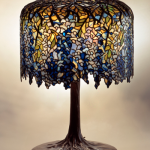This exhibition at the Morse includes more than 30 objects, including not only Tiffany’s signature styles but examples by other makers of the period who were also vying for a stake in the explosive market for electric light in the home.
In his 1904 catalog Tiffany Lamps, Tiffany described his clever and richly colored lampshades as “pieces of glass bound together with copper and welded together, producing the effect found in our floral and geometrical windows.” From the 1890s on, world expositions boldly celebrated electrified light, giving it the attention formerly reserved for master furniture or fine art. Tiffany Studios’ production was so innovative and successful that other decorative arts manufacturing firms produced spinoffs of Tiffany designs for the middle class by using finished white metal in place of bronze for bases and by limiting the options in design and glass selection to keep costs down.
Award-Winning Electric Lamps
At the 1902 Prima Esposizione Internazionale d’Arte Decorativa Moderna, in Turin, Italy, Tiffany Studios was awarded a grand prize for two lamps that transformed standard lamp forms into electrified sculptures from nature: the Pond Lily and Wistaria lamps. This ambitious decorative arts exposition put an emphasis on the aesthetic renewal of everyday objects. Many of Tiffany’s early lighting designs were oil lamps that required a base that could serve as a fuel source and a shade that provided ventilation for an open flame. Electricity made new designs for lighting possible. The delicate form of the Pond Lily lamp housed only wire and small light bulbs that followed the natural down-turned orientation of the lilies. On the Wistaria lamp, the bronze vine completely envelops the top of the shade.
Tiffany Lamp Screens
Lamp screens were among the fancy goods Tiffany Studios offered for sale with its lamps. These decorative screens were attached to a large lamp’s finial by chain and suspended below the shade, shielding the person using the lamp from its bare light bulbs. These leaded-glass screens were available in the shapes of the winged insects or figures that appropriately might hover around Tiffany’s’ garden of nature-themed lamps.
Lamps by Tiffany Contemporaries
Consumers of Louis Comfort Tiffany’s day found a plethora of choices in electric lighting, and many were imitations of Tiffany’s own phenomenally successful leaded-glass lamps. Among the high-quality lighting fixtures and lamps from Duffner & Kimberly Company in New York City—whose founders included a former Tiffany employee—is a Flaming Sword lampshade that depicts a stylized bromeliad bloom. Cincinnati Artistic Wrought Iron Works, with salesrooms in Cincinnati and Chicago, advertised that its artisans were “pioneers in metal artcraft.” Unique Art Glass & Metal Company of Brooklyn, New York, made Tiffany-type lamps at popular price points. The company lowered costs by fabricating fewer styles and using more economical materials, sheet metal and cast iron, for example, instead
of bronze. Standard-sized lamps that could fit into many decorative settings were often called “portable” lamps.










